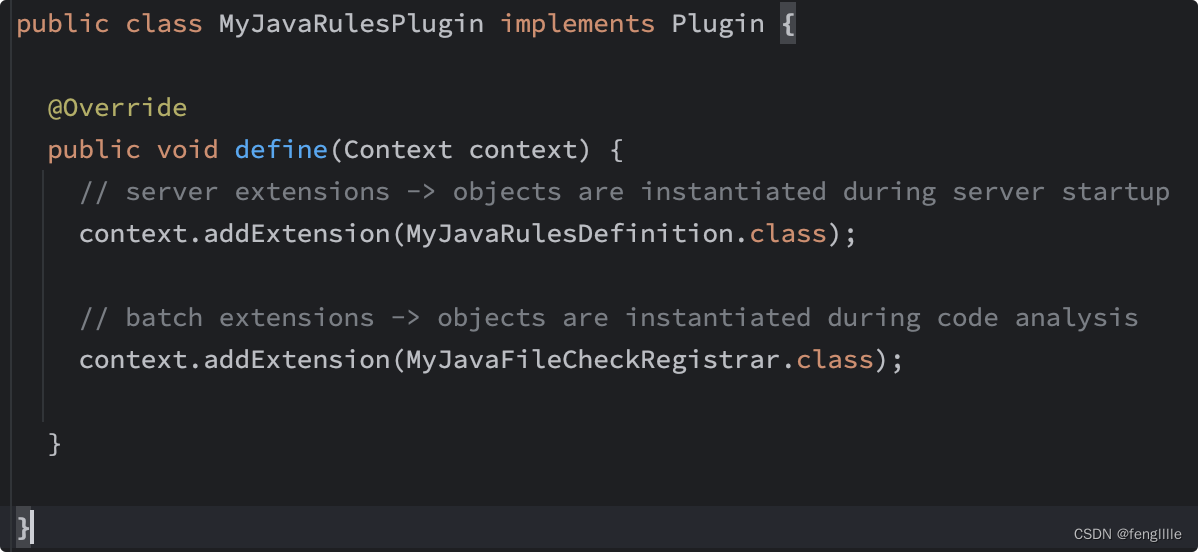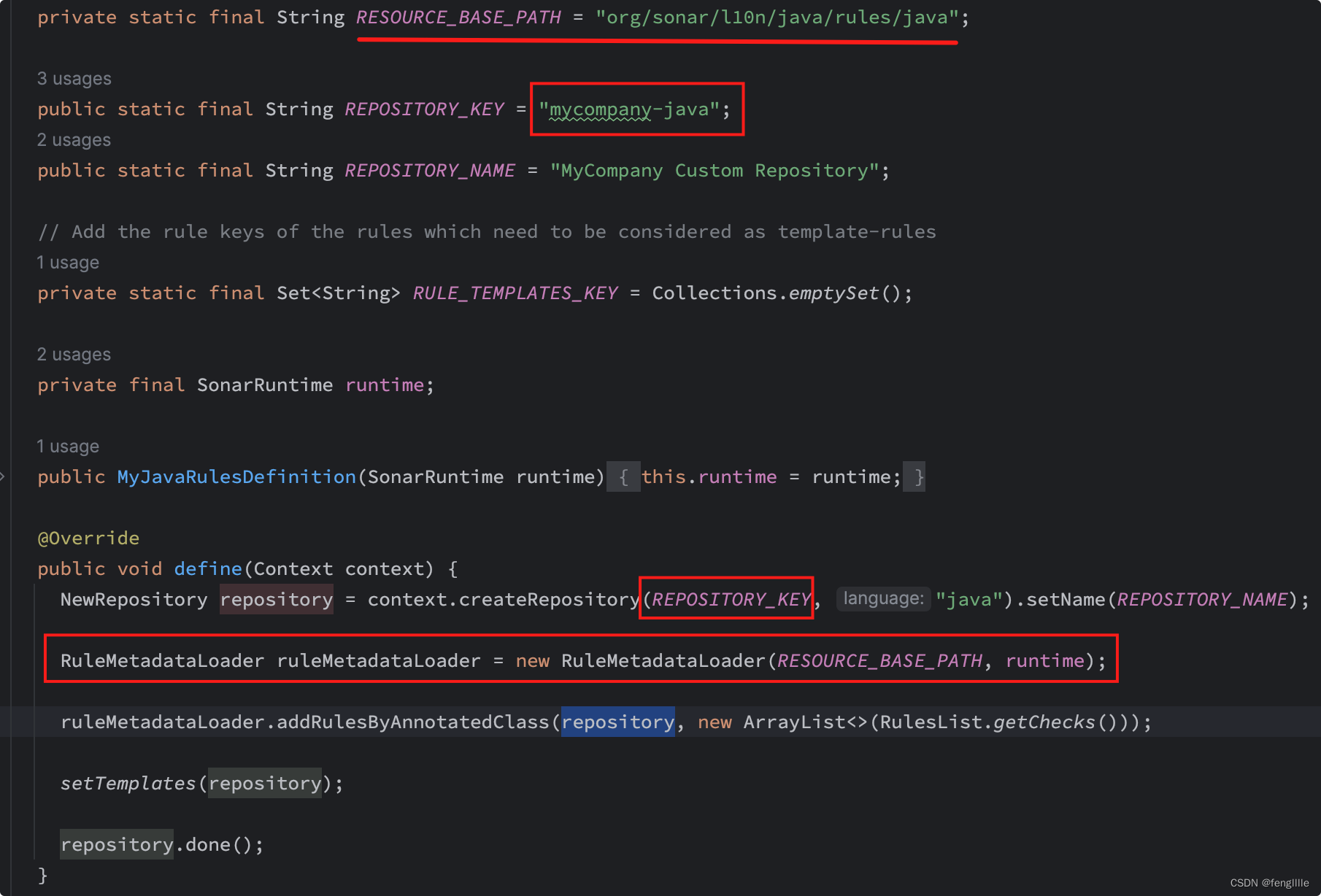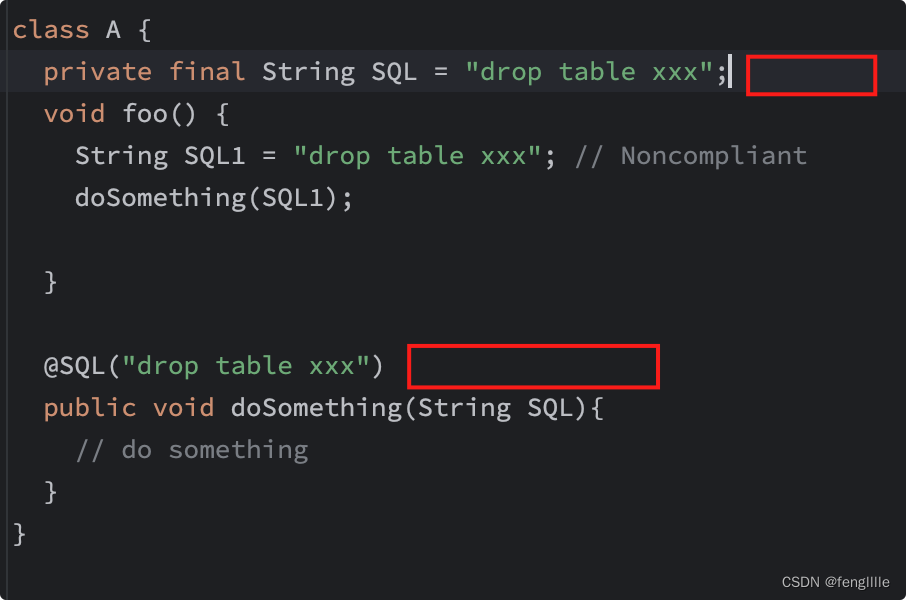前言
最近做项目,定制sonar规则,提高Java代码质量,在编写的sonar规则,做验证时,使用单元测试有一些简单的心得感悟,分享出来。
自定义规则模式
sonar的自定义规则很简单,一般而言有2种模式可以使用:
1. 自定义扫描代码逻辑,并对分类的Tree的结构处理
2. 使用已扫描的分类,对分好类的Tree进行分析
BaseTreeVisitor&JavaFileScanner
extends BaseTreeVisitor implements JavaFileScanner
继承Tree的访问器,实现Java文件扫描器

TreeVisitor定义了很多Tree的读取过程,当然我们也可以扩展这个过程,Tree是哪里来的呢,scan的接口实现的

IssuableSubscriptionVisitor
extends IssuableSubscriptionVisitor
继承发布订阅访问器,意思是sonar的sdk默认扫描出来,我们需要定义那些是我们需要的,就订阅处理相关的Tree处理,推荐使用这种方式,开发便捷,性能可以得到保障,毕竟扫描文件的算法,如果写的性能差,扫描会很久。
比如我们写一个扫描检查Java代码里的SQL的drop table语句
@Rule(key = "DropTableSQLCheck")
public class DropTableSQLCheck extends IssuableSubscriptionVisitor {private static final String RECOMMENDATION_DROP_MESSAGE = "Make sure that drop table \"%s\" is expected here instead of sql platform.";private static final String DROP_TABLE_STR = "DROP TABLE";//告诉sonar插件,我需要访问这个,这里定义了字符串,插件定义了很多,如果不符合要求就需要自定义扩展,同时需要扩展扫描器@Overridepublic List<Tree.Kind> nodesToVisit() {return Collections.singletonList(Tree.Kind.STRING_LITERAL);}// 访问我们刚刚要求的类型,已经安装Kind过滤了,扫描文件,归类的逻辑,已经sonar的API实现了,如果不符合要求才需要扩展@Overridepublic void visitNode(Tree tree) {if (!tree.is(Tree.Kind.STRING_LITERAL)) return;SyntaxToken syntaxToken = tree.firstToken();if (syntaxToken == null) return;String str = syntaxToken.text();if (StringUtils.isBlank(str)) return;String originStr = str;str = str.trim().toUpperCase();if (str.contains(DROP_TABLE_STR)) {reportIssue(tree, String.format(RECOMMENDATION_DROP_MESSAGE, originStr));}}
}这里没有考虑xml的SQL,包括字符串多个空格的考虑,理论上应该按照分析drop,然后为index逐个字符读取,如果是空格就读取下一个,如果是非t就return,如果下一个是非a就return,当然也可以使用正则。这里使用简化算法,做一个Demo

加上规则类,仿造写sonarqube的元数据

到此规则编写完成,后面分析单元测试逻辑
源码分析
简单分析下,代码执行逻辑,类似Java agent插件

从main的class执行

上下文加扩展,这里是一个注册扫描规则,一个注册扫描元数据,当然也可以合二为一,架构建议分离,所以Demo是分离的
元数据规则是sonarqube server启动实例化,启动就可以看到检查类别,检查类规则是代码分析时实例化

注册规则类,这里又分了是否用于test,上面的手写规则需要注入这个里面

元数据信息是路径扫描读取的,所以只要放在那个路径就行,通过@Rule的名称匹配文件名
这里的repository_key是sonarqube显式的规则名称,同时这里也可以扫描其他语言,比如xml
这里写好后,如果需要本地验证,则需要单元测试。
单元测试
编写单元测试代码,即使是不能编译的代码也可以扫描
class A {private final String SQL = "drop table xxx";void foo() {String SQL1 = "drop table xxx"; // NoncompliantdoSomething(SQL1);}@SQL("drop table xxx")public void doSomething(String SQL){// do something}
}编写test
public class DropTableSQLCheckTest {@Testvoid test() {((InternalCheckVerifier) CheckVerifier.newVerifier()).onFile("src/test/files/DropTableSQLCheck.java").withCheck(new DropTableSQLCheck()).withQuickFixes().verifyIssues();}
}载入需要扫描的文件和使用那个规则类检查
单元测试分析
单元测试写好后,出现这个错误

这并不是规则写的有问题或者规则没命中,而是一种断言,sonar的单元测试jar定义

如果扫描出问题,那么需要对有问题的行打上
// Noncompliant
开头的注释,否则断言不通过
规则来源于org.sonar.java.checks.verifier.internal.Expectations的
collectExpectedIssues
方法中
private static final String NONCOMPLIANT_FLAG = "Noncompliant";private final Set<SyntaxTrivia> visitedComments = new HashSet<>();private Pattern nonCompliantComment = Pattern.compile("//\\s+" + NONCOMPLIANT_FLAG);private void collectExpectedIssues(String comment, int line) {// 此处断言,收集断言有问题的代码行if (nonCompliantComment.matcher(comment).find()) {ParsedComment parsedComment = parseIssue(comment, line);if (parsedComment.issue.get(QUICK_FIXES) != null && !collectQuickFixes) {throw new AssertionError("Add \".withQuickFixes()\" to the verifier. Quick fixes are expected but the verifier is not configured to test them.");}// 放进预估issues.computeIfAbsent(LINE.get(parsedComment.issue), k -> new ArrayList<>()).add(parsedComment.issue);parsedComment.flows.forEach(f -> flows.computeIfAbsent(f.id, k -> newFlowSet()).add(f));}if (FLOW_COMMENT.matcher(comment).find()) {parseFlows(comment, line).forEach(f -> flows.computeIfAbsent(f.id, k -> newFlowSet()).add(f));}if (collectQuickFixes) {parseQuickFix(comment, line);}}同理,如果一个问题都没用,那么验证不了规则,直接断言失败
org.sonar.java.checks.verifier.internal.InternalCheckVerifier
private void assertMultipleIssues(Set<AnalyzerMessage> issues, Map<TextSpan, List<JavaQuickFix>> quickFixes) throws AssertionError {if (issues.isEmpty()) { // 没有错误示例,就断言失败throw new AssertionError("No issue raised. At least one issue expected");}List<Integer> unexpectedLines = new LinkedList<>();Expectations.RemediationFunction remediationFunction = Expectations.remediationFunction(issues.iterator().next());Map<Integer, List<Expectations.Issue>> expected = expectations.issues;for (AnalyzerMessage issue : issues) {validateIssue(expected, unexpectedLines, issue, remediationFunction);}// expected就是我们通过注释断言的sonar需要扫描出来的问题,如果有部分没有预计断言出来就会if (!expected.isEmpty() || !unexpectedLines.isEmpty()) {Collections.sort(unexpectedLines);List<Integer> expectedLines = expected.keySet().stream().sorted().collect(Collectors.toList());throw new AssertionError(new StringBuilder() //这里抛出断言缺失的错误或者错误断言的错误.append(expectedLines.isEmpty() ? "" : String.format("Expected at %s", expectedLines)).append(expectedLines.isEmpty() || unexpectedLines.isEmpty() ? "" : ", ").append(unexpectedLines.isEmpty() ? "" : String.format("Unexpected at %s", unexpectedLines)).toString());}assertSuperfluousFlows();if (collectQuickFixes) {new QuickFixesVerifier(expectations.quickFixes(), quickFixes).accept(issues);}}总结
sonar扫描实际上现在已经非常完善了,尤其是心得API的提供,很大程度不需要我们写什么东西,专注核心的扫描算法与Tree的解析,甚至大部分扫描算法都不需要写了,使用发布订阅即可,得益于心得API的提供,目前使用的很多API还是@Beta注解,但是开发效率极大的提升了,毕竟以前旧的sonar版本,需要我们自己写各种扫描与分析逻辑。不过sonar的单元测试与传统的单元测试是有一定区别的,sonar的测试逻辑是必须有一个问题测试案例,且需要打上
// Noncompliant
注释,注释的行既是命中的行,sonar使用行号作为map的key,这样sonar才认为是命中规则的。如果断言错误,或者断言的数量不对,那么也一样会单元测试失败。











)







